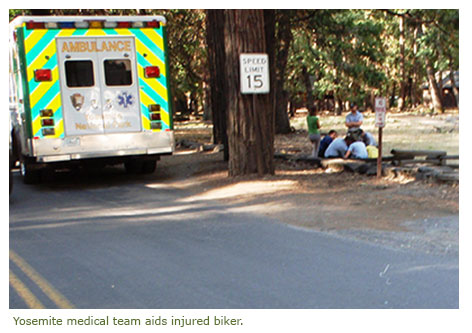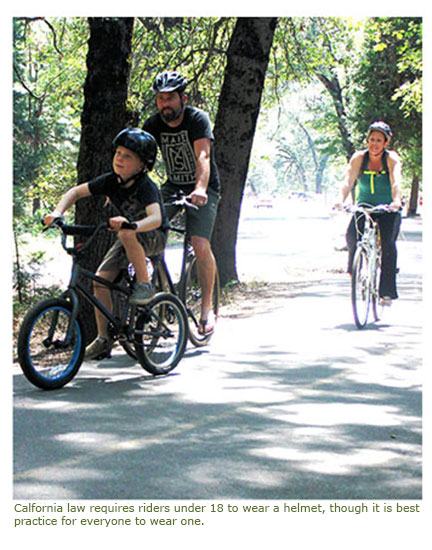When you hear about search and rescue or emergency medical services at Yosemite National Park, what environment comes to mind? What are the potential scenarios, especially when talking about traumatic injuries?
The following case occurred on the morning of July 16. Although there is nothing unusual about it, you might be surprised if this incident falls completely outside of your initial guesses.
The following case occurred on the morning of July 16. Although there is nothing unusual about it, you might be surprised if this incident falls completely outside of your initial guesses.

In short, this begins as a planned hike among two friends on a trail in the Tuolumne Meadows area. However, this hiker never gets out of the Valley. The plans are cancelled when one would-be hiker, a 23-year-old female, is riding her bike to meet up with her hiking partner. The bike rider is on a paved road with a long but gradual downgrade, so she is travelling at a pretty good clip as she approaches a left turn at a relatively busy intersection.
Because of her speed, our rider needs to cut the corner to negotiate her turn but a car suddenly appears and occupies her turning route. The rider takes evasive action to avoid the car but her speed renders her unable to control her bicycle and she crashes. Because our rider is not wearing a helmet, her head, instead of a padded helmet, makes direct contact with the ground.
A frontcountry traumatic injury under these circumstances actually becomes our rider's good fortune. A registered nurse riding her bike to work at the Yosemite Medical Clinic witnesses the crash and immediately reports the incident and attends to the now-fallen rider. The incident is also literally within a baseball's throw of the Valley search and rescue office, so medical providers are on hand almost immediately and an advanced life support ambulance is on scene only moments later. This is a stark contrast to a typical backcountry response, which is often measured in hours rather than seconds.
In any case, the ambulance transports the bike rider to the Yosemite Medical Clinic, where she is treated for a head injury. It appears she will eventually enjoy a complete recovery but this may take some time and the Tuolumne Meadows hike will now have to wait.
Lessons Learned
The first lesson learned involves bicycle laws. Without making any judgment about this specific case, bicycles generally have to follow the same rules as motor vehicles. In other words, bicyclists must ride on the right side of the road, stop at stop signs, signal their turns, and so on. This is a two-way responsibility: motor vehicle drivers need to respect bicyclists' right-of-way the same as with other motor vehicles. When all users of our roadways pay full attention to their operation and follow the rules of the road, encroachments or conflicts among users are very rare.
Second is the benefit to wearing a bicycle helmet. California law requires riders under 18 to wear helmets. Helmets are optional for bicycle riders 18 and over but they are an outstanding idea, inexpensive, and in many cases are the difference between a minor headache and life-altering or life-ending injuries. Unfortunately, when one observes bicycle operations in the Valley, the majority of adult bike riders, and even some children, opt to skip the helmet. Once the crash occurs, it's too late to reconsider your decision to skip the helmet.
In summary, bike riding is growing in popularity around the United States and in Yosemite. There are many benefits to bike riding, ranging from reducing traffic congestion and smog, greater mobility, personal heath, recreation, etc. However, please keep bike riding a safe and enjoyable experience by paying attention, following all of the rules of the road, and wearing a bicycle helmet.
Remember: the path to your backcountry experience begins with safety in the frontcountry.
Because of her speed, our rider needs to cut the corner to negotiate her turn but a car suddenly appears and occupies her turning route. The rider takes evasive action to avoid the car but her speed renders her unable to control her bicycle and she crashes. Because our rider is not wearing a helmet, her head, instead of a padded helmet, makes direct contact with the ground.
A frontcountry traumatic injury under these circumstances actually becomes our rider's good fortune. A registered nurse riding her bike to work at the Yosemite Medical Clinic witnesses the crash and immediately reports the incident and attends to the now-fallen rider. The incident is also literally within a baseball's throw of the Valley search and rescue office, so medical providers are on hand almost immediately and an advanced life support ambulance is on scene only moments later. This is a stark contrast to a typical backcountry response, which is often measured in hours rather than seconds.
In any case, the ambulance transports the bike rider to the Yosemite Medical Clinic, where she is treated for a head injury. It appears she will eventually enjoy a complete recovery but this may take some time and the Tuolumne Meadows hike will now have to wait.
Lessons Learned
The first lesson learned involves bicycle laws. Without making any judgment about this specific case, bicycles generally have to follow the same rules as motor vehicles. In other words, bicyclists must ride on the right side of the road, stop at stop signs, signal their turns, and so on. This is a two-way responsibility: motor vehicle drivers need to respect bicyclists' right-of-way the same as with other motor vehicles. When all users of our roadways pay full attention to their operation and follow the rules of the road, encroachments or conflicts among users are very rare.
Second is the benefit to wearing a bicycle helmet. California law requires riders under 18 to wear helmets. Helmets are optional for bicycle riders 18 and over but they are an outstanding idea, inexpensive, and in many cases are the difference between a minor headache and life-altering or life-ending injuries. Unfortunately, when one observes bicycle operations in the Valley, the majority of adult bike riders, and even some children, opt to skip the helmet. Once the crash occurs, it's too late to reconsider your decision to skip the helmet.
In summary, bike riding is growing in popularity around the United States and in Yosemite. There are many benefits to bike riding, ranging from reducing traffic congestion and smog, greater mobility, personal heath, recreation, etc. However, please keep bike riding a safe and enjoyable experience by paying attention, following all of the rules of the road, and wearing a bicycle helmet.
Remember: the path to your backcountry experience begins with safety in the frontcountry.

